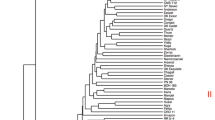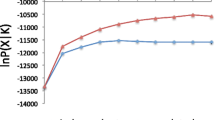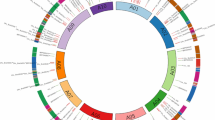Abstract
Until now, no distinct heterotic groups have been established in many rapeseed-growing countries. Numerous modern breeding lines with desirable seed quality have been developed but the loss of genetic diversity would be problematic. Simple sequence repeat markers covering all 19 B. napus linkage groups were used to evaluate the genetic diversity and to classify the heterotic groups of 169 Chinese semi-winter cultivars or inbred lines. The results indicate moderate genetic differentiation among the 169 accessions, which distributed in 10 major groups according to their pedigrees or origins. The Chinese accessions could be divided into two genotypes: northern restorers and southern maintainers for Polima cytoplasm male sterility. The maintainers consisted of nine clades originating from 10 major rapeseed-growing provinces in the upper, middle and lower reaches of the Yangtze River. The mid-parent heterosis on plant height and yield ability of the intragroup crosses was inferior to that of the intergroup hybrids. When the intragroup parental combinations with short genetic distances (GD) were included in all regressing data, GD is significantly correlated to heterosis level. Three major heterotic patterns were identified: (1) northern restorer × southern maintainer, (2) maintainer from the upper reaches of the Yangtze River × maintainer from the lower reaches of the Yangtze River and (3) maintainer from the middle Yangtze River × maintainer from the lower reaches of the Yangtze River. For the first time, the results showed the outline of heterotic groups in Chinese rapeseed under the conditions of the Huang-Huai River region.






Similar content being viewed by others
Abbreviations
- AAS:
-
Academy of Agriculture Science
- CMS:
-
cytoplasmic male sterility
- GD:
-
genetic distance
- GMS:
-
genic male sterility
- HAU:
-
Huazhong Agriculture University
- HRRC:
-
Hybrid Rapeseed Research Centre
- NWAFU:
-
Northwest A&F University
- OCH:
-
over-control heterosis
- ORI:
-
Oil Crop Research Institute
- MPH:
-
mid-parent heterosis
- PCoA:
-
principal coordinates analysis
- HPH:
-
high-parent heterosis
- PH:
-
plant height
- SCA:
-
specific combining ability
- SCI:
-
second cycle line
- SSR:
-
simple sequence repeat
References
Ahmad R, Li G, Quresh Z, Swati M, Quiros CF (2010) Genetic diversity of oilseed Brassica napus inbred lines based on sequence-related amplified polymorphism and its relation to hybrid performance. Plant Breed 120:411–415
Brandle JE, McVetty PBE (1990) Geographical diversity, parental selection and heterosis in oilseed rape. Can J Plant Sci 70:935–940
Brewin DG, Malla S (2012) The consequences of biotechnology: a broad view of the changes in the Canadian canola sector, 1969 to 2012. AgBioForum 15:257–275
Channa SA, Tian H, Mohammed MI, Zhang R, Faisal S, Guo Y, Klima M, Stamm M, Hu S (2018) Heterosis and combining ability analysis in Chinese semiwinter × exotic accessions of rapeseed (Brassica napus L.). Euphytica 214:134
Fu TD, Zhou YM (2013) Progress and future development of hybrid rapeseed in China. Eng Sci 11(5):13–18
Kebede B, Thiagarajah M, Zimmerli C, Rahman MH (2010) Improvement of open-pollinated spring rapeseed (Brassica napus L.) through introgression of genetic diversity from winter rapeseed. Crop Sci 50:1236–1243
Kim HR, Choi SR, Bae J, Hong CP, Lee SY, Hossain MJ, Nguyen DV, Jin M, Park BS, Bang JW, Bancroft I, Lim YP (2009) Sequenced BAC anchored reference genetic map that reconciles the ten individual chromosomes of Brassica rapa. BMC Genomics 10:432
Kumar S, Stecher G, Li M, Knyaz C, Tamura K (2018) MEGA X: molecular evolutionary genetics analysis across computing platforms. Mol Biol Evol 35:1547–1549
Leckband G, Frisch M, Snowdon RJ (2018) Genome-wide regression models considering general and specific combining ability predict hybrid performance in oilseed rape with similar accuracy regardless of trait architecture. Theor Appl Genet 131:299–317
Lees CJ, Li G, Duncan RW (2016) Characterization of Brassica napus L. genotypes utilizing sequence-related amplified polymorphism and genotyping by sequencing in association with cluster analysis. Mol Breed 36:155
Li DR, Tian JH (2015) Role and function of cultivar Qinyou 2 in rapeseed hybrid breeding and production in China. Chinese J Oil Crop Sci 37:902–906
Li HT, Chen X, Yang Y, Xu J, Gu J, Fu J, Qian X, Zhang S, Wu J, Liu K (2011) Development and genetic mapping of microsatellite markers from whole genome shotgun sequences in Brassica oleracea. Mol Breed 28:585–596
Luo X, Ma C, Yi B, Tu J, Shen J, Fu TD (2016) Genetic distance revealed by genomic single nucleotide polymorphisms and their relationships with harvest index heterotic traits in rapeseed (Brassica napus L). Euphytica 209:41–47
Melchinger AE, Gumber RK (1998) Overview of heterosis and heterotic groups in agronomic crops. In: concepts and breeding of heterosis in crop plants. CSSA Publication, Madison, pp 29–44
Pritchard JK, Stephens M, Donnelly PJ (2000) Inference of population structure using multilocus genotype data. Genetics 155:945–959
Qian W, Sass O, Meng J, Li M, Frauen M, Jung C (2007) Heterotic patterns in rapeseed (Brassica napus L.): I. Crosses between spring and Chinese semi-winter lines. Theor Appl Genet 115:27–34
Qian W, Li Q, Noack J, Sass O, Meng J, Frauen M, Jung C (2009) Heterotic patterns in rapeseed (Brassica napus L.): II. Crosses between European winter and Chinese semi-winter lines. Plant Breed 128:466–470
Rohlf FJ (2000) NTSYS pc2.1: numerical taxonomy and multivariate analysis system version 2.1. Applied Biostatistics Inc., New York. http://www.exetersoftware.com/cat/ntsyspc/ntsyspc.html. Accessed 30 May 2006
Tang QY, Zhang CX (2013) Data processing system (DPS) software with experimental design, statistical analysis and data mining developed for use in entomological research. Insect Sci 20:254–260
Tian HY, Channa SA, Hu SW (2017) Relationship between genetic distance, combining ability and heterosis in rapeseed (Brassica napus L.). Euphytica 213:1
Werner CR, Qian L, Voss-Fels KP, Abbadi A, Leckband G, Frisch M, Snowdon RJ (2018) Genome-wide regression models considering general and specific combining ability predict hybrid performance in oilseed rape with similar accuracy regardless of trait architecture. Theor Appl Genet 131:299–317
Wu D, Liang Z, Yan T, Xu Y, Xuan L, Tang J, Zhou G, Lohwasser U, Hua S, Wang H, Chen X, Wang Q, Zhu L, Maodzeka A, Hussain N, Li Z, Li X, Shamsi IH, Jilani G, Wu L, Zheng H, Zhang G, Chalhoub B, Shen L, Yu H, Jiang L (2019) Whole-genome resequencing of a worldwide collection of rapeseed accessions reveals the genetic basis of ecotype divergence. Mol Plant 12:30–43
Xu SX, Liu J, Liu GS (2004) The use of SSRs for predicting the hybrid yield and yield heterosis in 15 key inbred lines of Chinese maize. Hereditas 141:207–215
Yang M, Wang X, Ren D, Huang H, Xu M, He G, Deng XW (2017) Genomic architecture of biomass heterosis in Arabidopsis. Proc Natl Acad Sci U S A 114:8101–8106
Yu CY, Hu SW, Zhao HX, Guo AG, Sun GL (2005) Genetic distances revealed by morphological characters, isozymes, protein and RAPD markers and their relationships with hybrid performance in oilseed rape (Brassica napus L.). Theor Appl Genet 110:511–518
Yu C, Guo Y, Ge J, Hu Y, Dong J, Dong Z (2015) Characterization of a new temperature sensitive male sterile line SP2S in rapeseed (Brassica napus L.). Euphytica 206:473–485
Zhou Q, Zhou C, Zheng W, Mason AS, Fan S, Wu C, Fu D, Huang Y (2017) Genome-wide SNP markers based on SLAF-seq uncover breeding traces in rapeseed (Brassica napus L.). Front Plant Sci 8:648
Zou J, Mao L, Qiu J, Wang M, Jia L, Wu D, He Z, Chen M, Shen Y, Shen E, Huang Y, Li R, Hu D, Shi L, Wang K, Zhu Q, Ye C, Bancroft I, King G, Meng J, Fan L (2019) Genome-wide selection footprints and deleterious variations in young Asian allotetraploid rapeseed. Plant Biotechnol J 17:1998–2010
Availability of supporting data
All supporting data are included within the article and its additional files.
Funding
This work was financially supported by the projects from the National Key R&D Program of China (2016YFD0101300) and the Key R&D Program of Shaanxi Province (2018NY-055). The funding body played no role in the design of the study; the collection, analysis and interpretation of the data; and the writing of the manuscript.
Author information
Authors and Affiliations
Contributions
CYY conceived and designed the experiments and prepared the manuscript; QG, JLL and XRL carried out the experiments and ZH, AXX and JGD coordinated the study. All authors drafted and approved the final manuscript.
Corresponding author
Ethics declarations
Competing interests
The authors declare that they have no competing interests.
Additional information
Publisher’s note
Springer Nature remains neutral with regard to jurisdictional claims in published maps and institutional affiliations.
Electronic supplementary material
Table S1
The pedigrees and origins of plant accessions (DOC 285 kb)
Table S2
Sequences of SSR primers used in this study (DOC 31 kb)
Table S3
PCR amplification results of the SSR primers (DOC 58 kb)
Table S4
Results of the UPGMA cluster using all SSR markers (DOC 39 kb)
Table S5
Results of the neighbour-joining cluster using all SSR markers (DOC 37 kb)
Table S6
Correlation coefficients among the two year‘s data of plant height and yield (DOC 31 kb)
Table S7
Plant height and seed yield of the elite parents and their F1 hybrids (XLSX 15 kb)
Rights and permissions
About this article
Cite this article
Gong, Q., Lian, JL., Li, XR. et al. The genetic diversity and heterotic groups of 169 Chinese semi-winter rapeseed (Brassica napus) cultivars and inbred lines. Mol Breeding 40, 35 (2020). https://doi.org/10.1007/s11032-020-01121-z
Received:
Accepted:
Published:
DOI: https://doi.org/10.1007/s11032-020-01121-z




